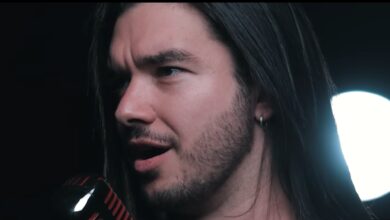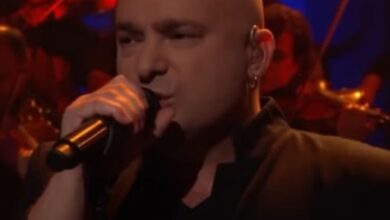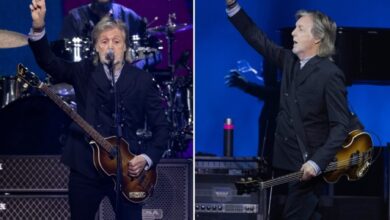The Classic Rock Show Climbed Led Zeppelin’s Summit with a Spellbinding “Stairway to Heaven” in Leicester
Many believed nothing could come close to Ann Wilson’s breathtaking 2012 Kennedy Center rendition of Led Zeppelin’s “Stairway to Heaven,” yet the moment The Classic Rock Show let the first gentle chords drift across a sold-out hall, doubts began to evaporate. Over eight stirring minutes the British ensemble carried listeners on the same mystical climb Jimmy Page and Robert Plant mapped in 1971, proving that reverence and daring can share the same stage.
Released in November 1971 on Led Zeppelin’s untitled fourth album, “Stairway to Heaven” fused pastoral folk, electrified blues, and prog-rock ambition into a multisection epic that quickly became every aspiring guitarist’s final exam. It remained a fixture of FM playlists for decades, and in recent years the Library of Congress even deemed it culturally significant enough to preserve for future generations.
The Classic Rock Show was conceived in the late 2000s as a living, breathing jukebox dedicated to meticulous, note-for-note recreations of rock’s most demanding catalog. Its founders believed great songs deserve to be experienced at arena volume long after original line-ups retire, so they built a touring production able to swap effortlessly between Hendrix fire, Queen grandeur, and Floyd psychedelia without missing a cue.
Musical director and lead guitarist James Cole anchors a formidable lineup that often features bassist-vocalist Wayne Banks, drummer Tim Brown, vocalist-guitarist Jesse Smith, keyboardist Henry Burnett, and powerhouse singers Jess Harwood and Rudy Cardenas. Each member is chosen not just for virtuosity but for scholarly devotion to the material, allowing them to reproduce studio nuances many tribute acts gloss over.
One of the most replayed captures of their Zeppelin homage was filmed at Leicester’s De Montfort Hall in early 2018 and uploaded later that year. The clip opens with Cole’s six-string acoustic picking so precise it could have spilled out of Island Studios in 1970, then pans to a wall of Marshall stacks waiting for the inevitable voltage surge that defines the song’s dramatic arc.
Veteran engineers Gareth Darlington and Andrea Pellegrini manned the console that night, blending whisper-quiet passages and thunderous climaxes into a widescreen sonic tapestry. Darlington sculpted crystalline highs for the chiming twelve-string, while Pellegrini coaxed a foundation-rattling thump from Brown’s kick drum, recreating John Bonham’s famed “hammer of the gods” impact without swallowing the mix.
The anticipation surrounding their performance was heightened because Wilson’s Kennedy Center tribute had ended with Robert Plant visibly wiping away a tear, leading many purists to declare the conversation closed. Rather than retreat, The Classic Rock Show leaned into the challenge, rehearsing the song dozens of times until every dynamic swell felt simultaneously spontaneous and inevitable.
From the rafters down to the cheap seats, an almost sacred hush greeted the opening verse, “There’s a lady who’s sure…,” and skepticism melted as Smith’s tenor floated confidently through Plant’s labyrinthine melody. By the second verse Harwood’s harmonies shimmered above the mix, adding a ghostly sheen reminiscent of Sandy Denny’s ethereal work on “The Battle of Evermore.”
The acoustic sections relied on a pair of Martin D-28s strung with extra-light gauges, chosen to capture Jimmy Page’s glassy sparkle while allowing rapid shifts to barre chords. Cole and Smith subtly pushed the tempo forward by a heartbeat during transitional bars, mirroring Page’s own habit of nudging phrases ahead to keep the narrative drifting yet urgent.
When electricity cracked the quiet at the five-minute mark, Cole slung a hand-wired 1959-spec Les Paul through a replica Hiwatt head, chasing the warm, mid-scooped snarl Page favored on stage. His solo built upon Page’s melodic skeleton but introduced rapid-fire trills and tasteful sweeps that hinted at contemporary shred without feeling anachronistic.
Behind them, Burnett’s keyboards added Mellotron-style string pads, a subtle detail that deepened the arrangement the way John Paul Jones’s understated Hammond swells once did. Listeners often cite this texture as the reason the Leicester rendition feels cinematic rather than merely accurate; it breathes between guitar lines, giving the climactic solo room to glow.
Vocally, Smith resisted the temptation to overshoot Plant’s famous high A’s, focusing instead on breath control and vowel placement that conveyed the lyric’s shifting moods—from misty Celtic allegory to apocalyptic warning. Harwood’s harmonies tucked into pockets of space, creating a sonic tapestry that echoed a cathedral choir without ever burying the lead.
The band placed “Stairway to Heaven” near the end of its first set, a daring programming choice that risked overshadowing everything that followed. The gamble paid off: a three-minute standing ovation bridged directly into a ZZ Top boogie, demonstrating that the emotional peak of “Stairway” didn’t drain the night’s remaining energy but instead turbocharged it.
By the middle of the 2020s, The Classic Rock Show had logged more than a thousand performances across Europe and North America, each night fielding fresh requests for their Zeppelin centerpiece. High-school guitarists, prog aficionados, and skeptical boomers found common ground in the Leicester video, proof that meticulous tribute can rekindle passion for the originals rather than dilute it.
Classic songs endure because skilled storytellers keep them alive. Gareth Darlington and Andrea Pellegrini’s flawless mix, The Classic Rock Show’s scholarly musicianship, and the courage to tackle a track many consider untouchable combine to remind us that there is always another rung on Led Zeppelin’s fabled staircase—and always another generation eager to climb toward that shimmering refrain.





